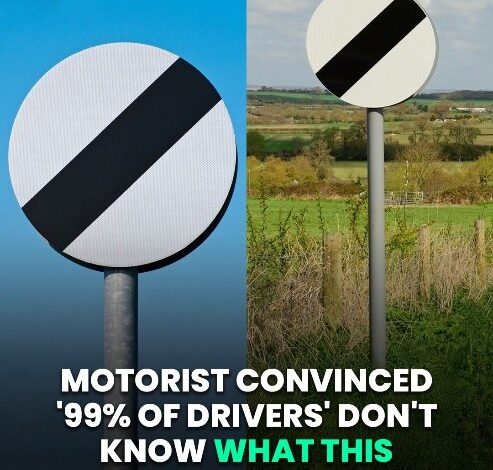
This Road Sign Confuses Almost Every Driver!
Across the United Kingdom, millions of drivers rely on road signs to guide them, enforce order, and maintain safety. Yet one sign in particular—a white circle with a thick black diagonal stripe—continues to confuse even seasoned motorists. Recently, a driver sparked online debate by insisting that “99% of drivers” don’t actually know what it means. Judging by the flood of responses, his claim wasn’t far from the truth.
Despite appearing simple, the sign has baffled generations of drivers. Some laugh it off as meaningless, while others wrongly assume it gives them license to floor the accelerator. The reality is more nuanced: this is the national speed limit sign, one of the most misunderstood markers on British roads.
The sign officially indicates that the national speed limit applies from that point forward. But here’s where confusion creeps in—it doesn’t mean the same number for everyone. For cars and motorcycles, the limit is 60 mph on single carriageways and 70 mph on dual carriageways and motorways. For vehicles towing trailers or larger vans, the limit drops to 50 mph on single carriageways and 60 mph on dual carriageways and motorways. In built-up areas with street lighting, the default limit remains 30 mph, regardless of whether the national speed limit sign is displayed.
While this layered system is tested thoroughly in the driving theory exam, most drivers stop thinking about it once they pass. Over time, the details fade, replaced by bad habits and cultural myths. Many forget the exact numbers and interpret the sign as “drive as fast as you think is safe.” Others crack jokes about it meaning “unlimited speed zone” or “national drifting area.” These misconceptions, though humorous online, create dangerous behavior on real roads.
Safety experts stress that the sign does not give permission to drive recklessly. Instead, it sets the maximum legal speed for that road type and vehicle. Conditions like rain, fog, traffic, or poor visibility often demand far lower speeds, regardless of what the sign allows. A driver misreading the sign could end up speeding unintentionally, exposing themselves to penalties or, worse, causing an accident.
The problem isn’t entirely with drivers. The sign itself is abstract, symbolic rather than explicit. Unlike signs with clear numbers or icons, it requires knowledge of the Highway Code to understand. Its meaning also varies depending on the type of road and vehicle, which adds layers of complexity. Combine that with the fact that refresher education is rare once drivers leave the test center, and it’s easy to see why confusion persists.
The consequences can be serious. Picture a motorist entering a single carriageway at night. He sees the black-and-white stripe and assumes it means 70 mph. He speeds up, unaware that the correct limit is 60 mph. Maybe the road bends sharply, or conditions worsen. Suddenly that small misunderstanding becomes a dangerous situation. Similarly, a van driver who doesn’t realize his towing limit is 60 on motorways might unknowingly break the law, only to find out the hard way during an accident investigation.
Organizations like the RAC and AA have long campaigned to raise awareness. They remind drivers that just because you legally can drive at 60 or 70 doesn’t mean you should. The “safe speed” often depends on judgment more than law. Road safety officers frequently note that accidents often occur not because people completely ignore signs, but because they interpret them too loosely.
Some experts argue for clearer communication. Ideas include adding supplementary plates under the sign with reminders like “Cars: 60 mph on single carriageways, 70 mph on dual carriageways” or “Check limits for vans and trailers.” Others suggest digital tools might play a bigger role. Many modern cars already detect speed limit signs using cameras and display the information on dashboards. Ensuring these systems interpret the national speed limit sign correctly could reduce confusion. Navigation apps could also offer reminders about what the sign means depending on the road type and vehicle settings.
But technology can only go so far. Ultimately, the responsibility falls on drivers to refresh their knowledge. The Highway Code is freely available and updated regularly, yet few experienced drivers revisit it unless they’re forced. The assumption that “I already know the rules” leaves room for dangerous misunderstandings. Taking even a few minutes to review the basics could prevent accidents and penalties.
This single road sign also highlights a broader issue: passing the driving test doesn’t mean education ends. Roads evolve, vehicles advance, and laws change. What never changes is the need for constant awareness and humility. Drivers must recognize that what they learned at 17 won’t necessarily carry them safely through decades of driving without a refresher.
The national speed limit sign should serve as a reminder that knowledge, context, and judgment are as important as the law itself. It doesn’t invite you to press harder on the accelerator. It doesn’t mean “anything goes.” It simply marks the point where the law expects you to know the maximum speeds based on where you are and what you’re driving.
In the end, the conversation about this misunderstood sign isn’t just about one piece of road furniture. It’s about the gap between theory and practice, between what drivers learn for a test and what they actually remember on the road. It’s about the culture of driving that often prizes speed over caution, bravado over safety.
So the next time you see that white circle with a black stripe, remember that it’s not a riddle or a dare. It’s a test of your awareness. Are you the kind of driver who shrugs it off as meaningless, or the kind who knows exactly what it stands for? The answer could make all the difference between a safe journey and a dangerous mistake.




